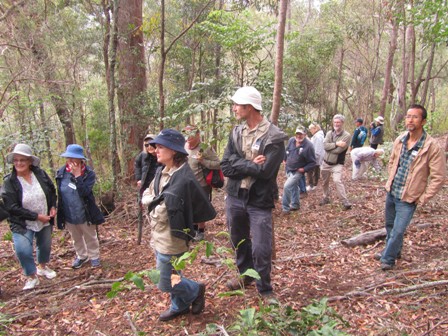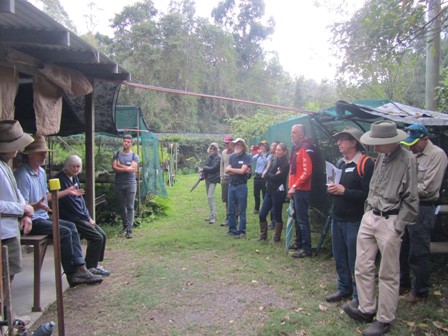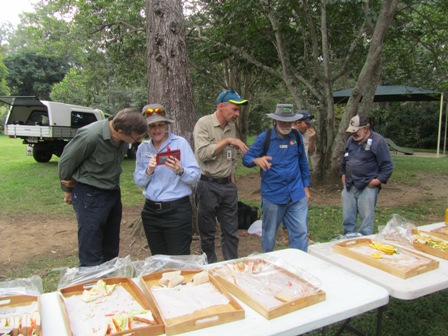On Sunday 16th June, MCCG hosted a very successful tour of the Moggill Creek catchment organised by Brisbane City Council (BCC).
The tour was attended by around 30 bushcare volunteers from around Brisbane as well as representatives from BCC’s Habitat Brisbane and Land for Wildlife programs. Our chairman Jim Pope has provided the following report:
The tour started at Dumbarton Drive, Kenmore, with a tour of the Lower Moggill Bushcare Group that has been supported by Habitat Brisbane since 2000 and is led by Judy Petroeschevsky.
The site stretches almost 1km along Moggill Creek from Kenmore State High School to Kilkivan Ave. Early works focused on the protection of creek banks in several high-flow reaches of the creek, using mass plantings of lomandras.
More recently, large Chinese elms (Celtis sinensis) have been removed along a 300m section and replaced with approximately 1000 native seedlings.
A particular feature of the site is an enormous Moreton Bay Fig tree (Ficus macrophylla) that is 35m tall with a canopy of 41m that is one of the largest of a single tree in any Brisbane park.
Next stop on the tour was a visit to the Blackbutt Park section of the McKay Brook bushcare group, near the confluence of McKay Brook with Moggill Creek.
This section was an addition to the Habitat Brisbane site in 2018 and consists of 500m of the west bank of Moggill Creek adjacent to Kensington Cct. and Parklane Tce.
It is dominated by incursions of Chinese Elms but the bushcare group led by Damien Egan recently obtained a Community Conservation Assistance (CCA) grant from BCC to remove a number of them from one end of the section across the footbridge at the bottom of Branton St. and replace them with natives.
After a delicious morning tea at the showgrounds, the tour then moved on to two adjacent Land for Wildlife (LFW) properties on a ridge overlooking Gold Creek Rd. The owners, Lynnette and Dianne have been registered with the LFW program for 11 years.
With assistance from BCC’s Wildlife Conservation Partnerships Program (WCPP) Lynette and Dianne have transformed large areas of the 4 hectare site that were once dominated by Lantana, Glycine, Easter cassia, Gidgee Gidgee and Climbing Asparagus.
The properties are a beacon for wildlife. Four seasonal bird surveys in 2014 sighted 58 species. Many tree hollows provide crucial habitat for Squirrel Gliders and areas now cleared of Lantana are now grazed by Red-necked and Swamp wallabies, while a friendly Echidna is often seen waddling along the paths.

Touring Lynette and Dianne’s Land for Wildlife property.
The tour then moved on to MCCG’s Native Plant Nursery at Gold Creek Dam, where Andrew Wilson and Bryan Hacker gave an overview of the nursery, (which has been operational since 1999), and showed the visitors around.
The nursery is staffed entirely by volunteers and provides between 12,000 and 15,000 native plants free of charge each year to members of MCCG and the Pullen Pullen catchment group.
They produce upwards of 200 species of native trees, shrubs, vines, forbes and grasses, mostly from seed collected locally, ensuring that plantings maintain the local provenance.


Andrew Wilson describes MCCG Plant Nursery operations.
The tour ended back at the Lower Moggill bushcare site, where participants enjoyed a delicious lunch before departing in time to avoid the afternoon storm!

Lunch disappeared fast!
Many thanks to Brisbane City Council, especially Andrew Wills, Paul Devine and Cody Hochen, for organising a very interesting and successful tour.
For more photos, please visit the MCCG Facebook page.

